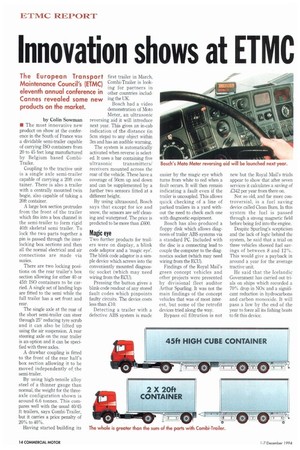Innovation shows at ETMC
Page 16

If you've noticed an error in this article please click here to report it so we can fix it.
The European Transport Maintenance Council's (ETMC) eleventh annual conference in Cannes revealed some new products on the market.
by Colin Sowman • The most innovative new product on show at the conference in the South of France was a dividable semi-trailer capable of carrying ISO containers from 20 to 45 feet long manufactured by Belgium based CombiTrailer.
Coupling to the tractive unit is a single axle semi-trailer capable of carrying a 20ft container. There is also a trailer with a centrally mounted twin bogie, also capable of taking a 20ft container.
A large box section protrudes from the front of the trailer which fits into a box channel in the semi-trailer to form rigid 40ft skeletal semi trailer. To lock the two parts together a pin is passed through the interlocking box sections and then all the normal electrical and air connections are made via suzies.
There are two locking positions on the rear trailer's box section allowing for either 40 or 45ft ISO containers to be carried. A single set of landing legs are fitted to the semi while the full trailer has a set front and rear.
The single axle at the rear of the short semi-trailer can steer through 25° reducing tyre scrub and it can also be lifted up using the air suspension. A rear staring axle on the rear trailer is an option and it can be specified with three axles.
A drawbar coupling is fitted to the front of the rear half's box section allowing it to be moved independently of the semi-trailer.
By using high-tensile alloy steel of a thinner gauge than normal, the weight for the threeaxle configuration shown is around 6.6 tonnes. This compares well with the usual 40/45 ft trailers, says Combi-Trailer, but it carries a price penalty of 20% to 40%.
Having started building its first trailer in March, Combi-Trailer is looking for partners in other countries including the UK.
Bosch had a video demonstration of Moto Meter, an ultrasonic reversing aid it will introduce next year. This gives an in-cab indication of the distance (in 5cm steps) to any object within 3m and has an audible warning, The system is automatically activated when reverse is selected. It uses a bar containing five
ultrasonic transmitters/ receivers mounted across the rear of the vehicle. These have a coverage of 50cm up and down and can be supplemented by a further two sensors fitted at a different height.
By using ultrasound, Bosch says that except for ice and snow, the sensors are self cleaning and waterproof. The price is predicted to be more than £600.
Magic eye
Two further products for trailers were on display, a blink code adaptor and a 'magic eye'. The blink code adaptor is a simple device which screws into the conveniently mounted diagnostic socket (which may need wiring from the ECU).
Pressing the button gives a blink-code readout of any stored fault codes which pinpoints faulty circuits. The device costs less than £10.
Detecting a trailer with a defective ABS system is made easier by the magic eye which turns from white to red when a fault occurs. It will then remain indicating a fault even if the trailer is uncoupled. This allows quick checking of a line of parked trailers in a yard without the need to check each one with diagnostic equipment.
Bosch has also produced a floppy disk which allows diagnosis of trailer ABS systems via a standard PC. Included with the disc is a connecting lead to couple the computer to the diagnostics socket (which may need wiring from the ECU).
Findings of the Royal Mail's green concept vehicles and other projects were presented by divisional fleet auditor Arthur Spurling. It was not the main findings of the concept vehicles that was of most interest, but some of the retrofit devices tried along the way.
Bypass oil filtration is not new but the Royal Mail's trials appear to show that after seven services it calculates a saving of £342 per year from there on.
Not so old, and far more controversial, is a fuel saving device called Clean Burn. In this system the fuel is passed through a strong magnetic field before being fed into the engine.
Despite Spurling's scepticism and the lack of logic behind the system, he said that a trial on three vehicles showed fuel savings of between 8 and 12%. This would give a payback in around a year for the average tractive unit.
He said that the Icelandic Government has carried out trials on ships which recorded a 70% drop in NOx and a significant reduction in hydrocarbons and carbon monoxide. It will pass a law by the end of the year to force all its fishing boats to fit this device.
























































































